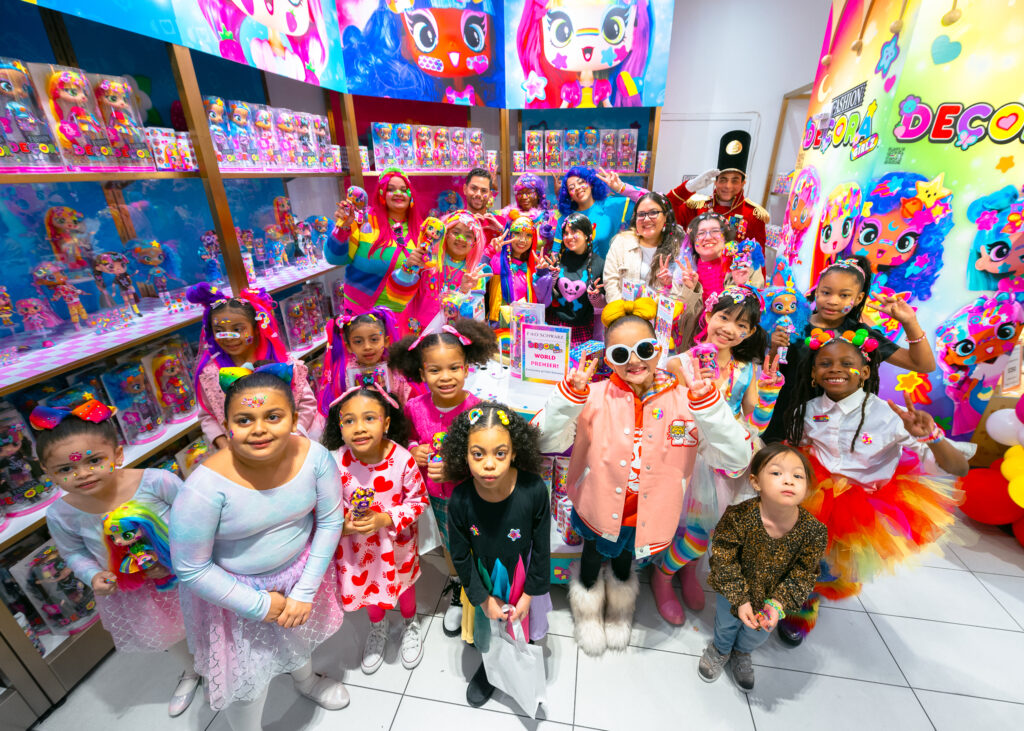When Barbie stepped into frame in her eponymous movie in an archival 1995 Chanel necklace — all pearls and dizzying jewels — it provided one example of just how intertwined the worlds of high fashion and toys are. But in 2024, a time ruled by screens and clicks, the physical fashion doll is in flux. Just how relevant is fashion, high and low, to the toys of the TikTok age?

The very brands competing in the category offer insight into the state of the fashion doll. Cepia, based in St. Louis, Missouri, released its Decora Girlz line in March. The dolls boast exaggerated chibi proportions and wear technicolor dresses, leg warmers, and tops. Yet their more-is-more clothes somehow play second-fiddle to the dolls’ main claim to fame: sticker and hair clip play.
The trait, unique among dolls, hails from a Japanese subculture known as Decora Kei. “Decora Kei actually means decorate and celebrate,” says Laura Freichs, Head of Marketing at Cepia. Though the line is Decora Kei through-and-through, she says Cepia CEO James Russell Hornsby was inspired when he caught his 5-year-old daughter putting Band-Aids on herself and her toys. “He decided to do a little bit of an internet search. And what he found is that there’s a whole culture behind this.”

The dolls launched at FAO Schwarz in March, where stickered and smiling kid influencers played with the 5- and 11-inch dolls. “What we really want them to do is to understand and appreciate the fashion details,” Freichs says, “but also really get, at the same time, the creativity and creative expression and just the ability to be empowered in your own decision-making, how you style yourself.”
If customization is key for Cepia doll developers, precision and authenticity are on the minds of the team at The Dr. Lisa Co.
The Black-owned brand is known for its multicultural toys. For Dr. Lisa Williams, the company’s Founder and CEO, it’s about centering fun, faithful representation (for example, creating your own dreadlock weave for dolls when, as Williams says, “no one had ever done locks in mass production before”). The company’s fashion dolls, The Fresh Beats, as well as its line of male dolls, The Fresh Squad, showcase these cultural specifications with an authentic edge.
Digital and social awareness, too, is a factor for The Dr. Lisa Co. and its fashion choices. Lui Domingo, The Dr. Lisa Co.’s Principal Designer, says a doll’s design, given its 18-month production timeline, has to match the stride of consumer tastes, tastes which form at sometimes breakneck speed. “In terms of fashion, [consumers] have access to what went on the Paris runways, for instance, in real-time as it is happening,” Domingo says, “versus the previous generation, where you have to wait for the Sunday paper.”
Williams adds, “We do look at the runway, but you also … just look around the community.” One such instance occurred when Domingo was designing for The Fresh Squad. Inspiration struck on an Atlanta subway car. “I was looking at this guy who was dressed so cool…He was wearing kind of sweatpants, but they’d been designed to look like you could almost wear them to dinner,” Domingo says. “So these are sort of emblems of a certain generation in a lot of ways. Borrowing from them allows you to speak the language of the current generation.”
While street style and subcultures certainly do influence toys, it would be erroneous to say that the love affair between high fashion and toys has fizzled. Barbie remains the poster child for this ongoing entanglement.

“One of my all-time favorites was the Karl Lagerfeld Barbie,” says Vice President of Barbie Doll Design Robert Best. “Designing a doll that so perfectly captured such a recognizable style icon and in partnership with an amazing team was a career highlight.”
The Lagerfeld Barbie was released in 2014; Mattel has also recently collaborated with Olivier Rousteing of Balmain, and a new program, Styled by Design, ushers Mattel designers into the sartorial spotlight. “Fashion is an evolving art that is most exciting when it reflects the new voices and ideas in culture,” Best explains.
Then again, high fashion is not the end-all-be-all, even for Barbie.
“Designing for dolls is similar to designing for the runway in that we work diligently to ensure our designs are current and on-trend, or even ahead of the trends,” Best adds. “While it is important that there are elements that relate to real clothes, we have a lot more freedom and ability to explore a wider range of themes like mermaids, astronauts, or princesses when it comes to doll scale.”
From fantasy play to street style to haute couture, as the category’s sales ride the high of renewed interest, the fashion doll reiterates a truth: Some things never truly go out of style.
A version of this feature was originally published in The Toy Book’s 2024 Licensing & Entertainment Issue. Click here to read the full issue! Want to receive The Toy Book in print? Click here for subscription options!









